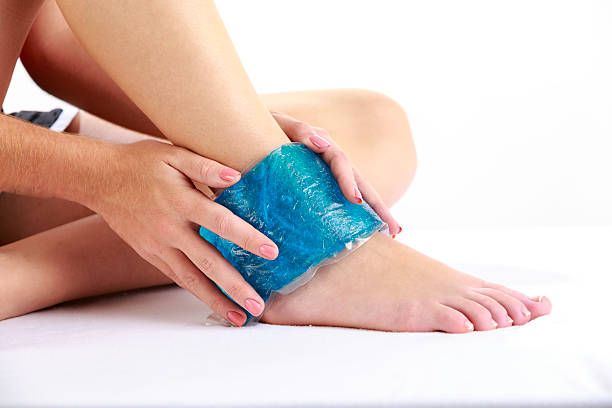Unraveling the Ice vs Heat Conundrum for Swelling and Pain: A Comprehensive Guide

Unraveling the Ice vs Heat Conundrum for Swelling and Pain: A Comprehensive Guide
Table of Contents
- Introduction
- Background
- The Science Behind Cryotherapy and Thermotherapy
- The Rule of Thumb: When to Choose Ice or Heat
- Potential Risks and Precautions
- Call-to-Action
- Conclusion
- Frequently Asked Questions
I. Introduction
Ever twisted your ankle and wondered whether to reach for a bag of frozen peas or a hot water bottle? Swelling, pain, stiffness – these are common responses our bodies have to injuries. But, how we manage these symptoms can be a confusing dilemma, especially when it comes to the ice vs heat debate. This blog post aims to decipher this ubiquitous question based on expert advice and scientific consensus so that you can make an informed choice on when to use ice or heat to manage pain and swelling effectively.
II. Background
Heat and ice – they're two of the simplest, cheapest, and most readily available tools in our arsenal to alleviate pain and aid in recovery. Surprisingly, their scientific names, thermotherapy and cryotherapy, sound much more sophisticated. Beyond the complex nomenclature, each has its distinct science-backed benefits and applications, furnished with potential risks and precautions. Understanding these aspects just might save you from unnecessary suffering and facilitate a faster recovery.
III. The Science Behind Cryotherapy and Thermotherapy
Ice Therapy (Cryotherapy) Benefits
Ice therapy, also referred to as cryotherapy, is a trusted ally when it comes to dealing with acute injuries (those that are sudden and painful). The cold temperature dulls the nerve activity, numbing the pain and reducing inflammation caused by increased blood circulation. Ice therapy proves particularly beneficial for immediate injuries, sprains, and bruises that result in swelling. Swelling is the body's natural response, bringing healing components to the damaged area, but excessive swelling may cause discomfort and hinder recovery. Cryotherapy helps by constricting blood vessels, leading to a reduction in swelling.
Heat Therapy (Thermotherapy) Benefits
Heat therapy, otherwise known as thermotherapy, acts as a balm for more chronic pain situations such as arthritis and muscular tension. Applying heat to aching areas helps increase blood flow, loosening up stiff muscles, and enhancing flexibility by making connective tissue more elastic. It's also a good choice when dealing with Delayed Onset Muscle Soreness (DOMS) – that annoying soreness you feel a day or two after an intense workout.
IV. The Rule of Thumb: When to Choose Ice or Heat
Ice Therapy – Best Situations to Use
In general, use ice therapy for acute injuries (those less than 48 hours old), sprains, strains, and post-intense physical activity to help keep inflammation in check. It's also an ideal choice for managing pain and inflammation resulting from overuse injuries like tendonitis and bursitis. In some cases, your doctor may even suggest ice therapy for chronic conditions such as rheumatoid arthritis, so always abide by professional recommendations.
Heat Therapy – Optimal Applications
If you're dealing with chronic pain, muscle tension or stiffness, arthritis, or want to relax or soothe your body, opt for heat therapy. A warm bath, a hot pack, or even a heating pad can relax tightened muscles, enhance flexibility, and stimulate healing, making it an ideal choice pre-exercise and for treating DOMS. Keep in mind, heat therapy is not suitable for situations with intense swelling or inflammation.
V. Potential Risks and Precautions
Risks and Precautions for Ice Therapy
When using ice therapy, avoid applying ice directly to the skin as it can cause burns or cold-induced injuries. Keep the icepack wrapped in a thin towel or cloth barrier. Also, ensure you don't exceed 15-20 minute sessions, with at least an hour break between applications. Prolonged exposure to ice can damage tissues and nerves.
Risks and Precautions for Heat Therapy
Similar to ice therapy, avoid applying heat sources, such as heating pads, directly to your skin to prevent burns. Stick to the 15-20 minute rule for heat therapy sessions and refrain from using heat on swollen or inflamed areas as it can exacerbate the situation.
VI. Call-to-Action (CTA)
Interested in getting the latest insights on health, wellness, and recovery? Subscribe to our blog now and stay ahead with the most accurate, scientific information on everything health-related. Join the community of health-conscious readers and stay up-to-date with expert advice, tips, and best practices.
VII. Conclusion
When it comes to relieving pain and managing swelling, knowing when to choose between ice or heat therapy can significantly affect your recovery process. While general guidelines are helpful, always seek professional guidance from your healthcare provider to ensure you're on the right track to healing. Keep in mind the potential risks and precautions for each therapy, and look forward to improved comfort, speed, and efficiency on your recovery journey.
VIII. Frequently Asked Questions (FAQs)
Q: Can I alternate between ice and heat therapy for the same injury?
A: While it may seem a good idea, it's crucial to select the correct therapy based on your injury type and its duration. Misuse can hinder your healing process. Always follow your physician's advice.
Q: What's the recommended duration of applying ice or heat?
A: Aim for 15-20 minute sessions with at least an hour gap in-between to allow your skin to return to its regular body temperature. Watch for any adverse skin reactions throughout.
Q: Can I apply heat or ice directly to my skin?
A: No. Always wrap your hot or cold pack in a thin towel or cloth to protect your skin. Never apply it directly, as it can lead to burns or frostbite.